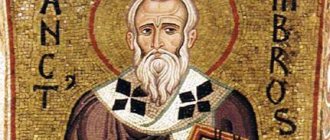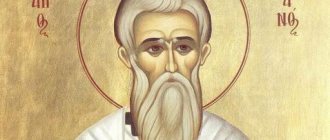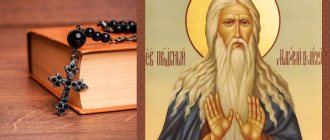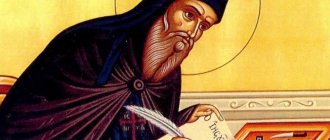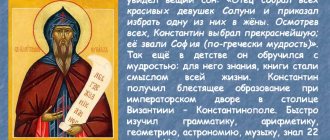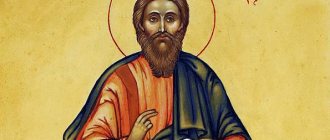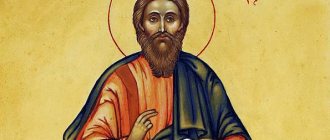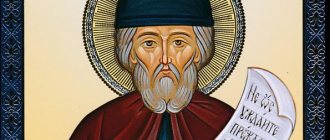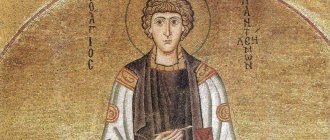| St. Cyril of Jerusalem |
Cyril I
(315 - 386), Bishop of Jerusalem, Saint Commemorated March 18
Born in Jerusalem in 315 and raised in strict Christian piety. Having reached adulthood, he became a monk, and in 346 he became a presbyter. In 350 or 351 after the death of Archbishop Maximus, he became his successor at the See of Jerusalem.
Living during the greatest unrest in the church from the Arians, he was overthrown by them three times from the episcopal see.
The heretic Akakios of Caesarea, deposed by the Sardician Council, decided to expel St. Cyril, using the assistance of the emperor (it is interesting that it was Akakios of Caesarea who at one time installed St. Cyril as bishop). When a severe famine occurred in Jerusalem, Saint Cyril spent all his property on works of mercy. Since the famine did not stop, the saint began to sell church items, using the proceeds to buy wheat for the hungry. The saint's enemies spread a rumor that they had seen a woman in the city dancing in sacred vestments. Taking advantage of this rumor, the heretics forcibly expelled the saint.
The saint found shelter with Bishop Silvanus in Tarsus. After this, the Local Council met in Seleucia, to which about 150 bishops arrived. Among them was St. Cyril, whom Metropolitan Akakios of Caesarea wanted to exclude from the meetings, but the Council did not agree. Then Akaki left the Council and before the emperor and the Arian Patriarch Eudoxius slandered both the Council and St. Cyril. The emperor subjected the saint to imprisonment.
When Emperor Julian the Apostate (361 - 363) reigned, he, supposedly out of piety, abolished all the decrees of Constantius directed against the Orthodox. Saint Cyril returned to his flock. After some time, when Julian established himself on the throne, he openly renounced Christ. He allowed the Jews to restore the Jerusalem Temple destroyed by the Romans and even allocated them part of the funds from state taxes for the construction. Saint Cyril predicted that the words of the Savior about the destruction of the very stones of the temple (Luke 21:6) would undoubtedly come true, and Julian’s blasphemous plan would fail. One night there was such a strong earthquake that even the surviving foundations of the ancient Solomon's temple moved, and the newly erected ones fell and crumbled to dust. When the Jews finally began construction again, fire fell from the sky and destroyed the working tools. Great horror gripped everyone. The next night, the sign of the cross appeared on the clothes of the Jews, which they could not destroy in any way.
After this heavenly confirmation of the prediction of Saint Cyril, he was expelled again, and Saint Cyriacus took the see of Jerusalem. But soon Saint Cyriacus suffered a martyr’s death (+ 363, commemorated October 28).
After the death of Emperor Julian, Saint Cyril returned to the see, but during the reign of Emperor Valens (364 - 378) he was sent into exile for the third time. Only under the holy and blessed Tsar Theodosius the Great (379 - 395) did he finally return to his archpastoral activities. In 381, Saint Cyril participated in the Second Ecumenical Council, which condemned the heresy of Macedonius and approved the Nicene-Constantinopolitan symbol.
Saint Cyril died in 386.
Life of Saint Cyril of Jerusalem
Christianity survived and spread throughout the world thanks to people who were not afraid to go against the pagan laws existing in their country. In the 4th century, Cyril lived in Jerusalem, a man who firmly believed in Christ and devoted his entire life to serving the Savior. Nothing is known about his childhood.
Cyril was born (presumably) in 315 in Jerusalem or its environs. Having accepted Christianity, he decided to preach the teachings of Christ to people. In 335 he was ordained deacon by Archbishop Macarius of Jerusalem. He served in this rank for ten years. In 345 another archbishop, Maximus, was awarded the presbyteral degree. As a presbyter, Cyril read sermons in the Jerusalem temple. His duties included preparing pagans for baptism.
In 351 Cyril was elected Archbishop of Jerusalem. The former head of the Jerusalem church, Maximus, may have been removed from his position. Although there is a version that he died. At the moment when Cyril became Archbishop of Jerusalem, a huge luminous cross appeared in the sky above the city. Such a sign was sent by God and meant that a truly pious Christian had become the head of the church in Jerusalem. Residents of the city gathered in the temple to listen to the sermon of their spiritual father. Many pagans, believing in the power of the Lord, converted to Christianity in those days.
The people of Jerusalem loved and respected their new shepherd. However, Cyril had enemies among the clergy. For many years he was in conflict with Akaki, Metropolitan of Palestine. The conflict was caused by differences in the interpretation of God's word. The Metropolitan of Palestine was an Arian; he did not like Cyril’s dogmatic views. Akaki was looking for a reason to remove the shepherd of Jerusalem, respected by the people, from his post. Soon the Metropolitan of Palestine had an opportunity to get even with the enemy.
A terrible disaster happened in Jerusalem - a terrible famine. People were starving and came to the temple, praying to God for salvation. The archbishop distributed all the church money to the hungry. True, this turned out to be not enough. A huge number of people could not buy bread and died of hunger. Then the archbishop ordered to sell church property (expensive vessels, curtains), and distribute the proceeds to the poor.
Akaki learned about affairs in the Jerusalem diocese. However, instead of praising Cyril, the Metropolitan of Palestine accused him of embezzling church money and selling off church property. Akaki convened a Council, at which the bishops decided to remove Cyril from the post of Archbishop of Jerusalem.
In 357, the former head of the church of Jerusalem left his hometown and its loyal inhabitants. In Tarsus he was sheltered by Bishop Silouan. Akakios, having learned where his longtime enemy was staying, sent a message to the local clergyman asking him not to host the removed Archbishop of Jerusalem. However, Silouan did not listen to him.
In 359, at the Council of Seleucia, the former Archbishop of Jerusalem was reinstated. However, Akaki in 360 gathered a new meeting of the clergy in Constantinople and again removed his enemy from governing the flock.
Cyril returned to Jerusalem only during the reign of Julian. True, the new ruler was a pagan, so he did not particularly favor Christians. Julian even ordered the construction of a Jewish temple in Jerusalem. All the Jews of the city joyfully received this news. Only the archbishop was not happy about the decree. He predicted that there would be an earthquake that would leave no stone unturned in the Jewish temple. Soon the prophecy of the Christian shepherd came true.
After Julian, the Arian Valens ascended the throne. In 367 the new emperor expelled the old archbishop from Jerusalem. More than ten years have passed. Theodosius I became the new ruler of the lands. In 379, the Archbishop of Jerusalem returned to his see. In 381, Cyril attended the Second Ecumenical Council in Constantinople, thanks to which the Nicene-Constantinople Creed was adopted. The following year, at a meeting of the clergy, the Archbishop of Jerusalem was praised for his services to the church. In 386 (387) the clergyman Cyril died. He died on March 18, so a holiday was established in his honor on this day.
Theological position
Although his theology was at first somewhat vague in phraseology, he undoubtedly adhered carefully to Nicene Orthodoxy. Even if he did avoid the debatable term homoousios
, he expressed his meaning in many passages, which equally exclude Patripassianism, Sabellianism, and the formula “there was a time when the Son was not” is attributed to Arius.[13]
In other points he adheres to the usual foundations of the Eastern Fathers, as in the emphasis on free will, autexusia
(αὐτεξούσιον) and in his view of the nature of sin.
For him, sin is a consequence of freedom, and not a natural state. The body is not the cause, but the instrument of sin. The cure for this is repentance, which he insists on. Like many Eastern fathers, he emphasizes a highly moral lifestyle as essential to true Christianity. His doctrine of the Resurrection is not quite as realistic as that of the other fathers; but his concept of the Church is clearly empirical: the existing ecclesiastical form is the true one, intended by Christ, the consummation of the Church of the Universe. Old Testament. His interpretation of the Eucharist is disputed. A little [ WHO?
] argue that he sometimes seems to approach the symbolic point of view, although he professes a strong realist doctrine. Bread and wine are not just elements, but the body and blood of Christ.[1]
Kirill's writings are filled with the loving and forgiving nature of God, which was somewhat unusual in his time period. Kirill fills his writings with great lines about the healing power of forgiveness and the Holy Spirit, for example: “The Spirit descends softly and reveals itself with its fragrance. He is not considered a light burden for God, very light. Rays of light and knowledge flow before him as the Spirit approaches. The Spirit comes with the tenderness of a true friend to save, heal, teach, counsel, strengthen and comfort.” Kirill himself followed God's message of forgiveness many times throughout his life. This is most clearly seen in his two major exiles, where Cyril was disgraced and forced to abandon his position and his people. He never wrote or showed hostility towards those who offended him. Kirill emphasized the themes of healing and rebirth in his catechesis.[16]
Meaning and veneration in Orthodoxy
Cyril of Jerusalem adhered to the traditional interpretation of the word of God. Throughout his life, he tried to convey the truth of Christ to people darkened by various errors. He wrote several works that are still used today as church teaching. In his writings, the Archbishop of Jerusalem clearly and accurately outlined the main tenets of the Christian faith. Thanks to Cyril, believers received the teaching about the Trinity, the sacraments of baptism, confirmation, and the Eucharist.
For his services to the church, the Archbishop of Jerusalem was canonized as a saint. The saint's memorial day falls on March 18 (31). The liturgy in honor of His Holiness Father Cyril is held by both the Orthodox and Catholic churches.
Literature
- N. I. Barsov, “Representatives of the dogmatic-polemical type of preaching in the 4th century.” (Kharkov, 1886);
- Touttée (at his publication of the works of Cyril of Jerusalem), “De vita et rebus gestis, de scriptis et de doctrina Cyrilli”;
- Tillemont, “Mémoires...” (vol. VIII);
- Oudin, “De script. eccesiast." (Vol. I);
- Ceiller, “Histoire générale des auteurs” (Vol. VI, after the 1860 edition);
- monographs:
- Plitt, "De Surilli orationibus, quae exstant" (Heidelberg, 1855);
- Marquardt, "S. Cyrillus, baptismi, chrismatis, eucharistiae interpres" (Leipzig, 1882);
- Archimandrite Porfiry, “Cyril of Jerusalem,” in “Additions to the works of St. fathers" (in Russian translation, 1855).
Iconography
The ancient images of the saint that have survived to this day date back to the 14th century. On the icons the saint was depicted in full growth or waist-length, but always dressed in a long robe with crosses. Cyril was depicted as a middle-aged man with dark (gray) hair, a small beard and a bare head. On some icons he is depicted wearing a pointed cap. In his left hand the saint holds the Gospel or a scroll, and with his right hand he blesses the believers. There are icons depicting the saint in many churches. If desired, the most holy image can be purchased at the church shop.
Recommendations
- Walsh, Michael, ed. Butler's Lives of the Saints.
(HarperCollins: New York, 1991), p. 83. - Jackson, Samuel Macaulay, ed., "Cyril of Jerusalem", The New Schaff-Herzog Encyclopedia of Religious Knowledge
, (3rd ed.) Pp. 334, London and New York, Funk & Wagnalls, 1914 - Butler, Alban. Lives or Fathers, Martyrs and Other Principal Saints
Vol. III, D. & J. Sadlier, & Company, 1864 - ^ a b
* Lives of the Saints for Every Day of the Year, edited by Rev. Hugo Hoover, S.D., Ph.D., New York: Catholic Book Publishing Company, 1955, p. 112 - A.
- Jerome gives a gloomy account of this appointment, claiming that Cyril was an Arian, and "was offered the throne after the death of Maximus on the condition that he would refuse his ordination at the hands of that bishop." (Yarnold (2000), p. 4) Jerome had personal reasons for his malicious behavior, and the story may simply be a case of Cyril submitting to proper church order. Young (2004), p.186
- Sozomen, ON
, 4.25 - Frances Young with Andrew Teale, From Nicaea to Chalcedon: A Guide to Literature and Its Background", (2nd ed. 2004), p. 187
- Drivers 2004, paragraph 65.
- Di Berardino, Angelo. 1992. Encyclopedia of the Early Church. New York: Oxford University Press. , item 312
- The reasons for this turn are not entirely clear. According to Theodoret, ( OH
2.23), Acacius informed the emperor that one of the items sold by Cyril was a "sacred robe" consecrated by Constantine himself, which subsequently turned Constantius against Cyril. However, the truth about this is not clear. - Norris 2007, para. 77.
- ^ a b
Chapman, John. "Saint Cyril of Jerusalem." Catholic Encyclopedia. Vol. 4. New York: Robert Appleton Company, 1908, March 16, 2015. - ^ a b
Foley, Leonard O.F.M., "Saint Cyril of Jerusalem",
Saint of the Day
, (edited by Pat McCloskey O.F.M.), Franciscan Media - ^ a b c
Andrew Louth, "Palestine", in Frances Young et al.,
The Cambridge History of Early Christian Literature
, (2010), p.284 - Hellemo, Geir. Adventus Domini: Eschatological Thought in 4th Century Apses and Catecheses
, BRILL, 1989 ISBN 9789004088368 - * "The Holy Penguin Dictionary, 3rd Edition", Donald Attwater and Katherine Rachel John, New York: Peguin Putnam Inc., 1995, p. 101
- Catechetical lectures of St. Kirill
- Sebastian S. Brock, Review of A. Desreumaux, Codex sinaiticus Zosimi rescriptus
(Lausanne, 1997), in
Journal of Theological Studies NS
50, 1999, p. 765. - Title of the fifth catechesis at Sinai, Georgian NF 71; https://sinai.library.ucla.edu
- The main evidence for this dating is that at one point Cyril casually mentions Mani's heresy about the age of seventy ( Cat
6.20).
Andrew Louth, "Palestine", in Frances Young et al., The Cambridge History of Early Christian Literature
, (2010), p.284 - Kirill, Catechesis V
- Drivers 2004, paragraph 7.
- Drivers 2004, pp. 13-14.
- Bergin, Liam. On Propheticum Lavacrum
, Gregorian Bible Book Store, 1999 ISBN 9788876528279 - ^ a b c
Calleres, Dayna S.,
City of Demons: Violence, Ritual, and Christian Authority in Late Antiquity
, California Press, 2015 ISBN 9780520956841 - English translation is in Telfer (1955).
- Frances Young with Andrew Teale, From Nicaea to Chalcedon: A Guide to Literature and Its Background", (2nd ed. 2004), p. 192
- Cain, Andrew and Lenski, Noel Emmanuel. The Power of Religion in Late Antiquity
, Ashgate Publishing, Ltd., 2009 ISBN 9780754667254 - Farrow, Douglas. "Rediscovering the Eschatological Perspective", The Oxford Handbook of Eschatology
(Ed. Jerry L. Walls), Oxford University Press, USA, 2007 ISBN 9780199727636 - Cyril and Gifford 1894.
- Froom 1950C. 412–415.
- Swaans (1942) makes the main argument for John's authorship; Doval (2001) argues at length against the Swans case. The arguments are summarized in Frances Young with Andrew Teale, From Nicaea to Chalcedon: A Guide to Literature and Its Background", (2nd ed. 2004), p. 189
- See, for example, Yarnold (1978). Frances Young with Andrew Teale, From Nicaea to Chalcedon: A Guide to Literature and Its Background", (2nd ed. 2004), p. 190
Orthodox texts
Saint Cyril is considered a man who opened the eyes of millions of believers to the basic tenets of Christianity. The saint is glorified for his teaching, which contains the words of true faith.
Kontakion
Believers glorify St. Cyril because he taught us to venerate and explained the meaning of the Trinity. The words of the wise teacher of the church enlightened the minds of a huge number of people.
Kontakion to Saint Cyril, Archbishop of Jerusalem, tone 4
With your tongue, wise one, / You enlightened your people with divine inspiration / the one Trinity of honor, / an indivisible nature, dividing the same Persons. / Moreover, rejoicing, your all-holy memory is ancestral We recognize those who offer you a prayer book to God.
Translation: Your word, O wise one, enlightened people with Divine inspiration, teaching them to honor the one Trinity, indivisible by Nature and divided by Persons. Therefore, rejoicing, we celebrate your all-holy memory, presenting you as a prayer book to God.
Canon
The canon, consisting of 9 songs, is pronounced in honor of the Mother of God and in honor of the great enlightener Kirill. Believers pray to the Immaculate Virgin to save souls from destruction and bestow grace.
Canon to Saint Cyril, Archbishop of Jerusalem
Song 1
Irmos: Tristates strong, Be born of the Virgin, dispassion in the depths, flood the tripartite soul, I pray that You, as in the tympanum, in the mortification of the body will sing a victorious song.
Having adorned the soul with the form of virtues, you completed the grace of this Holy Spirit, from where you vomited the abyss of wisdom, drying up the abyss of heresies, Cyril.
Having surpassed the mind of things you have done, you have shown yourself to be an accomplice of immaterial servants, and with the fire of your words you have consumed the whole thing of heresies, Cyril, the never-ending luminary of the Church.
Your word, with the sweet-breathing stench of the fury of the namesake, the wise one, drove away all the heresies intolerable feces, and created you far away, like the truest shepherd, like the fragrance of Christ ex.
Theotokos: From the times of passions, thoughts of anxiety, from the arrows of the evil one, from every adversary, save, O Pure Mother of God, the souls of those who sing of Your untold Nativity, O All-Immaculate One.
Song 3
Irmos: Because the Church has given birth to barren children, and many of the weak children of the congregation, let us cry to our wonderful God: Holy art thou, O Lord.
Shining with the lordship of spiritual wisdom, trissian Deity of the Trinity, Father, you have clearly made clear to those who exist on earth, from which we will be delivered from the darkness of darkness.
The Tsevnitsa appeared to you of the All-Holy Spirit, God-wise, proclaiming the song of the appearance of Christ, Whom you preached in two natures, delighting our souls.
Your soul has appeared in the house of holiness, in which the Father, and the Son, and the Life-Giving Spirit naturally dwell, and to Him we sing: Holy art thou, Lord.
Theotokos: Lower than the mind of heaven, more than the mind of Thy Nativity can say, O Young Lady, the Mind of the First in the womb of the Word, Pure One, conceived Thou, all things made up of words.
Sedalen, voice 8
Having enriched yourself with the wisdom of the Word, you vomited up the rivers of the living creatures from the teachings, and you gave water to every pious thought, and you fell with the divine club the flock on the grass, nourished by the divine out of my mind. Moreover, as a great shepherd and teacher and a faithful intercessor, we praise you, Saint Cyril, calling: pray to Christ, the God of sins, to forgive taxes to those who honor your holy memory with love ́.
Theotokos: Like a virgin and one in wives, Ty, who without seed gave birth to God's flesh, we please all, giving birth to humanity: fire has taken up residence in Ty of the Divinity, and like the Child, the daughter of Zizhd the Lord and the Lord. Therefore, the angelic and human race, we worthily glorify Your most holy Nativity and, in accordance with the cry of Ty: pray to Christ God to grant forgiveness of sins to those who worship in faith Your most holy Nativity .
Theotokos: The Lamb, and the Shepherd, and the Deliverer The Lamb beholds on the Cross, exclaiming, weeping, and, weeping bitterly, crying: the world rejoices, accept deliverance through You, my womb It burns, behold Your crucifixion, even as you endure mercy for mercy. Long-suffering Lord, abyss of mercy and inexhaustible source, be merciful and grant forgiveness of sins through faith to those who sing Your Divine Passion.
Song 4
Irmos: The heavens are covered with Thy virtue, and the earth is filled with Thy glory, O Christ. Moreover, we truly cry: Glory to Your power, Lord.
I stream the finest wisdom, sir, having accepted your heart, I will vomit the teachings into the abyss, plunging the minds of the ungodly.
You preached one fortress, one being, one will of the Trinitarian Divinity and polytheism, Cyril, the stream dried up the charms.
The clever and most insane Manentov, for he is intelligent and knowledgeable of God, blessed, having burned the brilliance of your words, he has clearly convicted you.
Theotokos: For having given birth to all creatures, the Pure One, you conceived the Creator of creation, and having given birth to nature, our nature is renewed.
Song 5
Irmos: You, Lord, my Light, you came into the world, Holy Light, turning those who sing Your praises from darkness of ignorance to faith.
With an honest rod, O saint, thy wisdom hast fallen on the water of Orthodox service to thy flock, O blessed one.
Your word is illuminated with Divine light, O Cyril! You destroyed the darkness of foolishness in the enlightened people in Jerusalem.
Theotokos: The Most Pure Night of passions and evil denigration covers my soul, giving birth to the Light-Giver, illuminate me, I pray.
Song 6
Irmos: The prophet Jonah cried out, prefiguring the three-day burial, praying in the whale: deliver me from aphids, O Jesus, King of hosts.
You are a river, like you came from another Eden, filled with the life-giving waters of the Spirit, and water the reins of the church, the saint.
The verb of your rays is that from the storm of the sea wickedness you save people, most sanctified, to the quiet haven of Orthodoxy calling them.
Theotokos: You have infuriated the earthed nature, All-immaculate, human and decayed, you have made new things, for this sake, O Youth, with all our silent voices we glorify You.
Kontakion, voice 4
With your tongue, wisdom, and divine inspiration, you enlightened your people with one Trinity of honor, inseparable by Nature, but divided by Persons. At the same time, rejoicing, we celebrate your all-holy memory, who also offer you a prayer book to God.
Song 7
Irmos: Three young men in Babylon, turning the command of the tormentor into violence, in the midst of the flames crying out: Blessed are you, O Lord, God our father.
Having fire in your mind, Father, the fear of God, you burned the sweets to ashes, chanting: Blessed are you, O Lord, God our father.
Having extinguished the flame with tears of passion, blessed one, you have preserved the light of your unquenchable soul, crying out: Blessed are you, O Lord, God our father.
Having a living stream with the flow of the Spirit, into the souls, God-wise, you have poured out, Father, rivers of teachings, the Church, watering, piously venerating.
Theotokos: The Holy One sanctifies all of You, taking flesh from Your flesh for Himself, O Theotokos, in the saints the living Lord, our God.
Song 8
Irmos: Omnipotent Redeemer of all, in the midst of the pious flame, He descended, watered you and taught you to sing: all you do, bless, sing to the Lord.
The slumber of negligence, blessed one, having abandoned the spiritual things, you have now fallen asleep like a righteous, decent one, and you have passed on to the day of the never-evening Light.
With the lightning of your words you struck down the boastful heresy, everlasting memory, and you enlightened the faithful to the one honor of the Trinity with inscriptions, in the Unity of the existing Nature.
Having sanctified yourself with your wives, you were dead for your sake, you sacrificed bloodlessly, like a Divine Hierarch, like a servant of the unspeakable mysteries, Kirill.
Theotokos: Having been delivered from the oath of the mother of God by You, O Pure Mother of God, Blessed Lady, we bless, O Most Glorified Virgin, Thy Most Holy Nativity, All-Pure One.
Song 9
Irmos: Eve, through the illness of disobeying the oath, instilled an oath, but You, Virgin Mother of God, through the vegetation of womb-bearing, the blessing of the world has blossomed. Thus we magnify you all.
Desiring to see the ineffable glory of Christ, the saint, you tried to mortify the soul-destroying passions and create greater and better wisdom for your heart. Moreover, we please you with faith.
Set a multi-bright star, Christ the Sun, on the church heights, Cyril, illuminating the hearts of those who faithfully fulfill your luminous memory, Reverend, with the rays of the sacred teachings.
Your interlocutor and co-celebrant was an angel, as if you were incorporeal, Father, having lived on earth, you appeared to be a venerable participant and an equal saint; Rejoicing with him, remember us.
The Mother of God: the well -defering God's virtues, the Most Holy Theotokos, the sourte show, the role, fruitfully, even from the Neckosyodov, I was growing up all the fulfilling maneuvers, but you sing, all -venerable.
Mystagogical catecheses
There is serious disagreement about the date and authorship of the Mystagogical Catecheses
, addressed to the newly baptized in preparation for receiving Holy Communion, with some scholars attributing them to Cyril's successor as Bishop of Jerusalem, John.[33]
Many scholars now view the Mystagogical Catecheses
as written by Cyril, but in the 370s or 380s rather than at the same time as the
Catechetical Lectures
.[34]
According to the Spanish pilgrim Egerius, these mystagogical catechesis
were given to the newly baptized in the
Anastasis
during Easter week.[15]
Creative heritage
The main work of the saint is considered to be the work “Catechetical Teachings”. This work is not a theological treatise, but a series of instructive conversations by Cyril. The sermons were delivered in the temple by the clergyman himself at the beginning of his bishopric. This work contains 1 preliminary and 18 catechetical teachings. The work was presumably written in 350-351. In the work, the author talks about the topic of baptism, the importance of repentance and confession of sins, and true worship of God.
The continuation of the “Catechetical Teachings” is the work “Secret Teachings.” Several more texts have survived to this day, the authorship of which is attributed to the saint. For example, “Message to Emperor Constantius”, “Sermon on the Gospel reading about the paralytic”. These works are a rich source of historical knowledge for Christians.
The “Message to Emperor Constantius” dates back to the year 351, when a huge luminous cross appeared in the sky over Jerusalem.
further reading
- Penguin Dictionary of Saints, 3rd edition
, Donald Attwater and Katherine Rachel John, New York: Peguin Putnam Inc., 1995, ISBN 0-14-051312-4 - Lives of the Saints for Each Day of the Year
edited by Rev. Hugo Hover, Senior Consultant, Ph.D., New York: Catholic Book Publishing Co., 1955 - Omer Englebert, Lives of the Saints
New York: Barnes & Noble Books, 1994, ISBN 1-56619-516-0 - Lane, A. N. S., & Lane, A. N. S. (2006). A Brief History of Christian Thought
. Grand Rapids, MI: Baker Academic. - Wang, N. P. (2007, January 1). "The Career of Cyril of Jerusalem (c. 348–87): A Reassessment." Journal of Theological Studies
, 58, 1, 134–146. - Di Berardino, Angelo. 1992 Encyclopedia of the Early Church
. New York: Oxford University Press. - In Cross, F. L., & In Livingstone, E. A. (1974). Oxford Dictionary of the Christian Church
. London: Oxford University Press.
